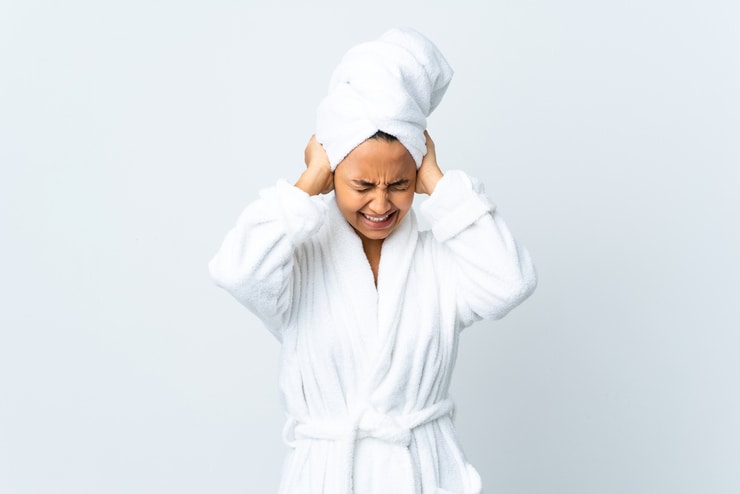Screeching, whining, or other high-pitched noises coming from your shower is a cry for help. But unfortunately, while these squealing whistling noises are pretty common in showers, they are not a sign of anything good.
The cause of high-pitched squeals is usually limescale or minerals that build up in your showerhead and its connecting pipes. Your water pressure tries to push through this limescale buildup which causes whistling. These noises occur when your showerhead has not been cleaned in some time.
But how does one go about cleaning their pipes and showerhead? Some specific products and tools can make this job easier and more efficient.
Take action by cleaning your showerhead and pipes to get rid of these annoying sounds before the issue gets any worse.

Why Does My Shower Make a Squealing or Whistling Noise?
Limescale Buildup
As stated earlier, limescale is the most common reason why showers emit an annoying squeal. Whenever water is heated or left standing, limescale will be there, making it a constant visitor to bathrooms.
Over the years, limescale will build up to the point it blocks the flow of water coming through your pipes and showerhead, which creates the squealing noise.
Mineral or Sediment Buildup
Like with limescale, other minerals and sediment can build up in your water system, giving you the same squealing result.
Minerals enter your water naturally through the water source or if you have hard water. Sediment is often carried by groundwater.
With mineral or sediment builds up, the solution is the same as limescale build up which is to clean your showerhead.
High Water Pressure
Everyone enjoys high water pressure, but your water pressure may be too high.
Overly high water pressure can cause squealing showerheads even when you have minor limescale or sediment buildup.
Water pressure can also build up in your pipes, causing many types of noises in your water lines and showerheads.
Worn Out Diverter or Shower Valve
If your shower whistles or squeals when switching from the bathtub to the shower the diverter valve is likely the culprit.
But if the squealing happens when you use the shower’s control handles, the shower valve is likely to blame.
Replacing shower valves and diverters can be a complex job involving cutting out part of your wall to access the plumbing. Therefore, a job like this should probably be left to a professional.
How to Eliminate Squealing or Whistling Noise When You Turn Your Shower On
Tools & Products You Will Need
- Pliers
- Wrench
- Socket Wrench
- Toothpicks
- Cloth or Rag
- Bowl
- Vinegar
- Brush (Disposable Toothbrush will do)
Solutions
Clean Your Showerhead
- Remove Your Showerhead
Begin by removing your showerhead. You don’t need to turn off your water supply to do this, but your shower should not be running.
You can use pliers or an adjustable wrench to turn the showerhead clockwise to remove it from the showers arm.
If your showerhead is giving you trouble, you can put a rag over the showerhead and give it your all without fear of damaging the showerhead.
- Clean Your Showerhead
With your showerhead removed, you can begin the cleaning process.
Use toothpicks to penetrate all of the holes in the showerhead to remove some of the buildup. Then rinse the showerhead with water to remove any loose material.
Lastly, pour vinegar into a bowl and completely submerge your showerhead in the vinegar for one hour.
- Replace and Check Your Showerhead
Take your showerhead out of the vinegar and thoroughly rinse it with water.
Before reattaching the showerhead, use vinegar and a small brush to remove any buildup on the pipe opening that connects to the showerhead and wipe it clean with a wet rag.
Once you reattach your showerhead run your shower and check if the squealing noise has gone away. If not, then something else may be to blame.
Reduce Your Water Pressure
- Locate Your Pressure Reducing Valve
The first thing you need to do is find your pressure-reducing valve, which is usually located near your shower shut-off valve or sometimes near your main water shut-off valve.
Some older homes may not have a pressure-reducing valve. In this case, you are best off contacting a plumber.
- Adjust the Valve
Pressure valves usually have a lock nut to prevent them from being adjusted unintentionally. Gently remove the lock nut, allowing you to adjust the pressure-reducing valve.
Find the right socket that fits on your pressure valve and attach a socket wrench. To reduce the pressure, you want to turn the wrench counterclockwise.
Be careful when reducing your water pressure, and don’t turn down on the wrench more than once or twice.
- Test Your Water
Run your water to see if the whistling noise went away.
You may have to adjust your water pressure multiple times to find the middle ground where the squealing is gone, but the water pressure is still high enough for you.
If you have a tool for measuring PSI, this process will be much easier.
FAQ
The leading cause of humming pipes is high water pressure. But leaks in your water system can also cause this issue.

